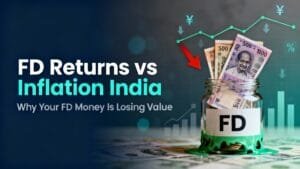Introduction: Why Gold ETF vs Silver ETF Matters for Indian Investors
Are you torn between investing in Gold ETF vs Silver ETF for your portfolio? You’re not alone. With India’s booming economy and increasing investor awareness, precious metal ETFs have become the go-to choice for portfolio diversification. But here’s the million-dollar question: which one delivers better returns?
Gold ETF vs Silver ETF isn’t just about picking shiny metals – it’s about understanding which investment aligns with your financial goals, risk appetite, and investment timeline. Whether you’re a 25-year-old starting your investment journey or a 40-year-old looking to hedge against inflation, this comprehensive guide will help you make an informed decision.
But first, let me share something that might surprise you…
Both Gold ETFs and Silver ETFs in India have delivered impressive 33%+ returns in the past year alone. However, the story doesn’t end there. The real question is: which one fits your investment strategy better?
What Are ETFs and Why They’re Perfect for Indian Investors
India boasts a fast-growing economy, and a significant portion of its population falls into the middle-income category. These conditions create an ideal environment for Exchange-Traded Funds (ETFs).
ETFs are investment funds that:
- Hold a collection of assets like bonds, commodities, or stocks
- Trade on stock exchanges like regular shares
- Provide instant diversification with a single purchase
- Offer lower costs compared to mutual funds
For Indian investors aged 18-45, ETFs represent the perfect blend of convenience, affordability, and growth potential. They eliminate the hassles of physical storage while providing exposure to precious metals.
Want to learn more about ETF investing strategies? Check out our Complete ETF Investment Guide: How to Generate 22% Returns with Just 15 Minutes Weekly for detailed insights.
Understanding Gold ETFs in India: The Traditional Choice
What is a Gold ETF?
A Gold ETF is an investment fund that tracks the price of gold and trades on stock exchanges like BSE and NSE. Unlike physical gold, Gold ETFs offer:
- Better liquidity – Buy and sell instantly during market hours
- Transparent pricing – Real-time price tracking of gold
- No storage costs – Eliminate locker fees and insurance
- No making charges – Save on jewelry-making costs
Gold ETF Performance in India
Key Performance Metrics:
- Average returns: 33.36% in the past year
- Tracking accuracy: Closely follows gold prices
- Liquidity: High trading volumes ensure easy entry/exit
Gold ETF: Benefits and Drawbacks
Advantages of Gold ETFs
- High liquidity: Trade on stock exchanges with ease
- No physical storage: Eliminate locker and insurance costs
- Cost-effective: No making charges unlike physical gold
- Portfolio diversification: Hedge against inflation and market volatility
- Transparent pricing: Real-time price updates
Disadvantages of Gold ETFs
- Management fees: Annual fees may reduce overall returns
- No dividend income: Returns depend solely on gold price appreciation
- No emotional value: Missing the traditional aspect of owning gold jewelry
- Price volatility: Affected by global economic events
Looking for high-return alternatives? Explore our guide on Beat Nifty 50 Returns: Best High Return ETFs in India to discover momentum-based ETF strategies.
Understanding Silver ETFs in India: The Affordable Alternative
What is a Silver ETF?
Silver ETFs track the price of silver and provide exposure to this precious metal without physical ownership. They’re particularly appealing for investors seeking affordable diversification options.
Silver ETF Performance in India
Key Performance Metrics:
- Average returns: 33% in the past year
- Industrial demand: Strong support from electronics, aerospace, and jewelry industries
- Volatility: Lower than gold due to abundant supply
Silver ETF: Benefits and Drawbacks
Advantages of Silver ETFs
- Cost-effective: Perfect for beginners with limited budgets
- Industrial demand: Strong fundamentals from multiple industries
- Portfolio diversification: Different risk-return profile than gold
- High liquidity: Easy to buy and sell at market prices
- No storage costs: Eliminate physical storage concerns
Disadvantages of Silver ETFs
- Price volatility: Affected by global economic factors
- Inconsistent returns: Driven by industrial usage patterns
- Management fees: Annual costs impact overall returns
- No physical ownership: Missing the tangible asset experience
Gold ETF vs Silver ETF: Detailed Comparison
Complete Comparison Table
| Parameter | Gold ETFs | Silver ETFs |
|---|---|---|
| Asset Type | Precious metal serving as traditional value storage and inflation hedge | Industrial precious metal with broad commercial applications |
| Liquidity | High – Easy to trade with strong market volumes | Moderate – Lower trading frequency compared to gold |
| Volatility | Higher – Limited supply and expensive mining processes | Lower – Abundant supply and easier mining |
| Returns | Higher long-term potential – Traditional safe haven asset | Moderate returns – Based on industrial demand cycles |
| Investment Cost | Higher – Due to gold’s premium pricing | Lower – More affordable for beginner investors |
| Market Maturity | Mature market – Established trading patterns | Developing market – Growing industrial applications |
Key Factors to Consider in Gold ETF vs Silver ETF Decision
1. Investment Goal Analysis
- Wealth preservation: Gold ETFs excel as inflation hedges
- Growth potential: Both offer similar recent returns (33%+)
- Portfolio diversification: Silver provides industrial exposure
2. Risk Profile Assessment
- Conservative investors: Gold ETFs offer stability
- Moderate risk-takers: Silver ETFs provide balanced exposure
- Aggressive investors: Consider both for complete precious metal exposure
3. Investment Timeline
- Short-term (1-3 years): Both suitable based on market conditions
- Medium-term (3-7 years): Gold typically outperforms
- Long-term (7+ years): Gold shows superior wealth preservation
Ready to build a comprehensive ETF portfolio? Our Best ETFs for Long Term Wealth: Complete Investment Guide covers advanced strategies for wealth building.
When to Choose Gold ETFs vs Silver ETFs
Choose Gold ETFs When:
- Long-term wealth preservation is your primary goal
- Inflation protection is crucial for your portfolio
- Economic uncertainty hedge is needed
- Higher investment capital is available
- Mature market exposure is preferred
Choose Silver ETFs When:
- Budget-friendly diversification is the priority
- Industrial growth exposure appeals to you
- Lower volatility suits your risk profile
- Beginner-friendly investment is needed
- Affordable entry point is required
Advanced Strategies: Gold ETF vs Silver ETF Portfolio Allocation
Balanced Approach: 70-30 Strategy
- 70% Gold ETFs: Core stability and inflation protection
- 30% Silver ETFs: Industrial exposure and growth potential
Aggressive Approach: 50-50 Strategy
- 50% Gold ETFs: Traditional safe haven benefits
- 50% Silver ETFs: Enhanced industrial demand exposure
Conservative Approach: 80-20 Strategy
- 80% Gold ETFs: Maximum stability and wealth preservation
- 20% Silver ETFs: Minimal industrial exposure
Want to generate regular income from ETFs? Check our comprehensive guide on How to Build Monthly Income from ETFs for income-focused strategies.
How to Start Investing in Gold ETF vs Silver ETF
Step 1: Choose Your Trading Platform
Get started with these free trading and demat accounts:
Step 2: Research and Select ETFs
- Compare expense ratios
- Analyze tracking accuracy
- Review liquidity levels
- Check fund house reputation
Step 3: Plan Your Investment Strategy
- Determine allocation percentage
- Set up SIP (Systematic Investment Plan)
- Define exit strategy
- Monitor performance regularly
Frequently Asked Questions (FAQs)
Conclusion: Making Your Gold ETF vs Silver ETF Decision
The Gold ETF vs Silver ETF debate isn’t about finding a universal winner – it’s about discovering what works best for your unique financial situation. Here’s what we’ve learned:
Gold ETFs shine when:
- Long-term wealth preservation is your goal
- You want proven inflation protection
- Higher investment capital is available
- Market stability is preferred
Silver ETFs excel when:
- Budget-friendly diversification is needed
- Industrial growth exposure appeals to you
- Lower volatility suits your risk profile
- You’re starting your investment journey
The Smart Investor’s Approach
The most successful investors don’t choose between Gold ETF vs Silver ETF – they strategically combine both. A balanced allocation of 70% Gold ETFs and 30% Silver ETFs provides:
- Stability from gold’s traditional safe-haven status
- Growth potential from silver’s industrial applications
- Diversification across precious metal categories
- Flexibility to adjust based on market conditions
Your Next Steps
Remember, the best investment strategy is one that aligns with your financial goals, risk tolerance, and investment timeline. Whether you choose Gold ETFs, Silver ETFs, or a combination of both, the key is to start investing and stay consistent.
Ready to take your ETF investing to the next level? Explore our complete collection of ETF investment guides for advanced strategies and insights.
The precious metals market is evolving rapidly – will you be part of the next wealth-building wave?
Disclaimer: This article is for educational purposes only and does not constitute financial advice. Please consult with a qualified financial advisor before making investment decisions.






